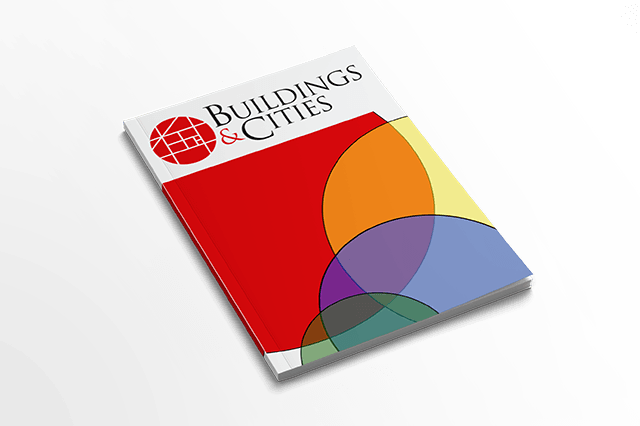
www.buildingsandcities.org/about/aims-and-scope.html
Aims & Scope

Buildings and Cities is an international, open access, peer-reviewed, academic journal publishing high-quality research and analysis on the interplay between the different scales of the built environment: buildings, blocks, neighbourhoods, cities, national building stocks and infrastructures.
The journal focuses on built environment policy, practices and outcomes and the range of economic, environmental, political, social and technological issues occurring over the full life cycle.
It provides a platform for new ideas, innovative approaches and research-based insights that can help improve the built environment.
Buildings & Cities aims to make research accessible and relevant to academics, policymakers, practitioners, clients, and occupants.
Buildings & Cities' wide scope embraces:
- SUSTAINABLE DEVELOPMENT GOALS (SDGs) & CLIMATE CHANGE: making cities, neighbourhoods and buildings inclusive, safe and resilient. Interactions with and impacts on: ecologies, biodiversity and ecosystem services; resource usage (land, water, air, energy, materials / mass flows); climate change (mitigation and adaptation, e.g. planning, design, management); transitions to low-carbon societies; carbon accounting / budgets; sustainable development (social, economic, environmental and natural capitals); regenerative development; circular economy, longevity and obsolescence; public health and wellbeing; public space and social inclusion; participatory planning and management; affordable housing; informal settlements; social justice (housing, rights to the city, land tenure, land use and value); resilience and long-term planning; urban development and land-use; urban density; urban morphology; spatial analysis; urban microclimates; rapid urbanisation; migration; links between urban, peri-urban and rural areas.
- ENERGY: energy and urban morphology, energy performance, energy policy, energy demand, energy behaviours, energy efficiency, exergy, mass retrofits, energy and carbon metrics, zero carbon buildings, embodied energy, energy epidemiology, renewable energy, energy storage, energy transitions, space heating, space cooling, district heating, energy retrofits, control systems.
- POLICY: urban governance; land use; density; resource consumption; well-being and public health; formulation and evaluation of public and institutional policies for buildings, neighbourhoods and cities; economic, environmental and social analysis of policies and regulations; policy outcomes; enforcement strategies; real estate market mechanisms; value capture; 'big data'; research and innovation capabilities; knowledge and technology transfer; organisational structures and networks; (stakeholder) institutions and institutional change; engagement processes; building regulations, alternative regulatory strategies for climate and energy issues
- PRACTICE, PERFORMANCE, OUTCOMES & IMPACTS: design, technical, social, organisational, and economic aspects of usability (fitness and adaptability); the performance and evaluation of urban areas, neighbourhoods and buildings; feedback loops; information access / sharing, including BIM, PoE and BPE data; the broad value and impacts of buildings, neighbourhoods, cities. Exploring the agency, capabilities, motivations and influence of public leaders, clients, professionals, urban citizens / inhabitants and others on decisions and outcomes over the project lifecycle. Professionalism, ethics, changing roles, professional services firms, public sector capabilities.
- SOCIETAL DEMANDS & CAPABILITIES: Defining and exploring the changing demands and aspirations on urban and architectural development; understanding citizens/inhabitants' desires, needs and behaviours; stakeholder participation, contractual agency, social justice/equity; value measurement and appropriation; performance of buildings and cities (as products and services); digital society: sensing, monitoring, control, AI and consumer services; stewardship and protection of societal interests; demographic changes, migration and urbanisation strategies.
Papers are published in the following formats:
- Research articles (up to 8,000 words) present the latest research
- Synthesis articles (up to 8,500 words) critically review the state of knowledge in key areas of interest
- Methods articles (up to 5,000 words) describe the development of innovative research methods and practices; new ways of understanding research
- Replication articles (up to 4,000 words) test previous findings and validate existing data sets. This can report on "failure" results. Registered reports are a submission option for replication studies, with peer review of the research design prior to the data collection.
- Policy Analysis articles (up to 3,000 words) put forward evidence-based analysis of particular policy approaches
- Briefing Notes (up to 2,500 words) make research results and their implications on key built environment topics accessible to the end users of research: policymakers, practitioners, clients or occupants.
Peer Review Statement
All manuscript submissions are subject to initial appraisal by the Editors, and, if found suitable for further consideration, to double-blind peer review by independent, anonymous expert referees. Further changes may be required in response to the reviewer's comments and suggestions. In all instances the Editor's decision on publication is final.
Transparency, Open Data & Ethics
Authors of published research must comply with BUILDINGS & CITIES' approach to standards of transparency. These include:
- Citation standards: Authors are required to provide appropriate citation for others' intellectual content, data and materials following this journal's author guidelines
- Data transparency:Data must be posted to a trusted repository. Exceptions must be identified at article submission.
- Analytic methods: Methods (including code / algorithms) must be posted to a trusted repository. Exceptions must be identified at article submission.
- Design & analysis transparency: Journal requires adherence to design transparency standards for review and publication.
- Study & analysis preregistration:Authors must state whether preregistration of study or analytical procedure exists and, if so, where to access it.
- Ethics: The research conforms with international human rights and ethical requirements of relevant research bodies, professional institutions and the author's organisation.
Journal Indexing, Abstracting and Archiving
This journal is indexed by the following services:
- ARCOM CM Abstracts
- BASE
- COPE
- Chronos
- CrossRef
- CNKI
- DOAJ
- EBSCO Host
- EBSCO Knowledge Base
- ERIH PLUS
- Ex Libris
- J-Gate
- JISC KB+
- JUFO (Finnish Publication Forum) - Level 2
- Norwegian Register for Scientific Journals
- OCLC
- Scopus - CiteScore (2024) of 5.5 (91st percentile: #18 of 203) and 91st percentile (Q1) in Engineering: Architecture; 84th percentile (Q1) in Social Sciences: Urban Studies; 81st percentile (Q1) in Social Studies: Geography, Planning & Development; 76th percentile (Q1) in Engineering: Building and Construction.
- Sherpa Romeo
In addition, the journal is available for harvesting via OAI-PMH.
To ensure permanency of all publications, this journal also utilises CLOCKSS, and LOCKSS archiving systems to create permanent archives for the purposes of preservation and restoration.
Plan S Compliance
In order to support authors to publish their research as open access, Buildings & Cities is compliant with Plan S. This ensures that authors looking to publish in journals are able to use funding provided by a cOAlition S organisation to cover the publication costs if applicable. Should you wish to check if this journal is compliant with your funder's OA policy, you can do so with the cOAlition S Journal Checker Tool.Latest Peer-Reviewed Journal Content
Designing for pro-environmental behaviour change: the aspiration–reality gap
J Simpson & J Uttley
Lifetimes of demolished buildings in US and European cities
J Berglund-Brown, I Dobie, J Hewitt, C De Wolf & J Ochsendorf
Expanding the framework of urban living labs using grassroots methods
T Ahmed, I Delsante & L Migliavacca
Youth engagement in urban living labs: tools, methods and pedagogies
N Charalambous, C Panayi, C Mady, T Augustinčić & D Berc
Co-creating urban transformation: a stakeholder analysis for Germany’s heat transition
P Heger, C Bieber, M Hendawy & A Shooshtari
Placemaking living lab: creating resilient social and spatial infrastructures
M Dodd, N Madabhushi & R Lees
Church pipe organs: historical tuning records as indoor environmental evidence
B Bingley, A Knight & Y Xing
A framework for 1.5°C-aligned GHG budgets in architecture
G Betti, I Spaar, D Bachmann, A Jerosch-Herold, E Kühner, R Yang, K Avhad & S Sinning
Net zero retrofit of the building stock [editorial]
D Godoy-Shimizu & P Steadman
Co-learning in living labs: nurturing civic agency and resilience
A Belfield
The importance of multi-roles and code-switching in living labs
H Noller & A Tarik
Researchers’ shifting roles in living labs for knowledge co-production
C-C Dobre & G Faldi
Increasing civic resilience in urban living labs: city authorities’ roles
E Alatalo, M Laine & M Kyrönviita
Co-curation as civic practice in community engagement
Z Li, M Sunikka-Blank, R Purohit & F Samuel
Preserving buildings: emission reductions from circular economy strategies in Austria
N Alaux, V Kulmer, J Vogel & A Passer
Urban living labs: relationality between institutions and local circularity
P Palo, M Adelfio, J Lundin & E Brandão
Living labs: epistemic modelling, temporariness and land value
J Clossick, T Khonsari & U Steven
Co-creating interventions to prevent mosquito-borne disease transmission in hospitals
O Sloan Wood, E Lupenza, D M Agnello, J B Knudsen, M Msellem, K L Schiøler & F Saleh
Circularity at the neighbourhood scale: co-creative living lab lessons
J Honsa, A Versele, T Van de Kerckhove & C Piccardo
Positive energy districts and energy communities: how living labs create value
E Malakhatka, O Shafqat, A Sandoff & L Thuvander
Built environment governance and professionalism: the end of laissez-faire (again)
S Foxell
Co-creating justice in housing energy transitions through energy living labs
D Ricci, C Leiwakabessy, S van Wieringen, P de Koning & T Konstantinou
HVAC characterisation of existing Canadian buildings for decarbonisation retrofit identification
J Adebisi & J J McArthur
Simulation and the building performance gap [editorial]
M Donn
Developing criteria for effective building-sector commitments in nationally determined contributions
P Graham, K McFarlane & M Taheri
Join Our Community

The most important part of any journal is our people – readers, authors, reviewers, editorial board members and editors. You are cordially invited to join our community by joining our mailing list. We send out occasional emails about the journal – calls for papers, special issues, events and more.
We will not share your email with third parties. Read more

Latest Commentaries
COP30 Report
Matti Kuittinen (Aalto University) reflects on his experience of attending the 2025 UN Conference of the Parties in Belém, Brazil. The roadmaps and commitments failed to deliver the objectives of the 2025 Paris Agreement. However, 2 countries - Japan and Senegal - announced they are creating roadmaps to decarbonise their buildings. An international group of government ministers put housing on the agenda - specifying the need for reduced carbon and energy use along with affordability, quality and climate resilience.
Building-Related Research: New Context, New Challenges
Raymond J. Cole (University of British Columbia) reflects on the key challenges raised in the 34 commissioned essays for Buildings & Cities 5th anniversary. Not only are key research issues identified, but the consequences of changing contexts for conducting research and tailoring its influence on society are highlighted as key areas of action.